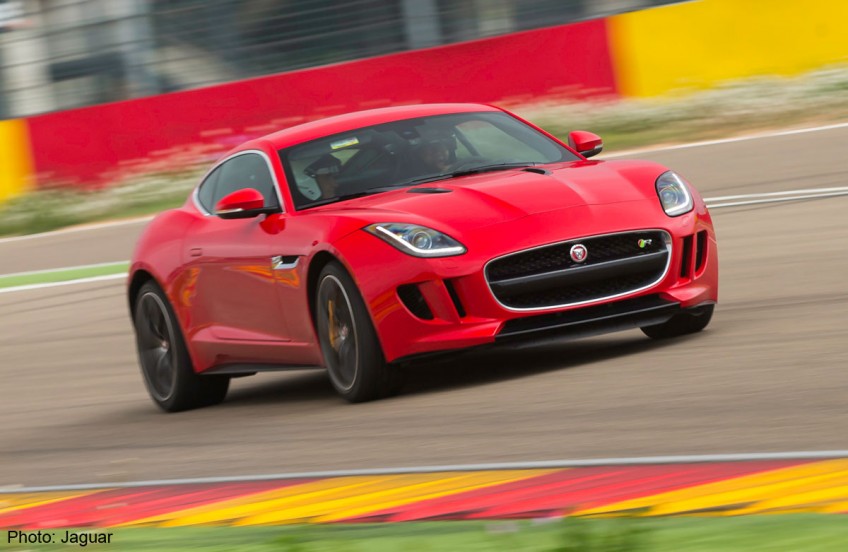Hot cat with a tin roof


It is standard practice for car- makers to launch the hardtop version of a new model first, with the convertible variant following several months down the road. But since Porsche bucked the trend with its Boxster/Cayman twins, Jaguar must have felt entitled to follow suit.
Hence the appearance of the F-Type R Coupe, a year or so after the debut of the roadster version.
The Coupe is exactly how you would expect a tin- topped F-Type to look like. Its feral face, voluptuous wheel arches, fluid curves and trademark long-nose, cab-back stance all remain unchanged. Just that where above the taut waistline was once clear sky, there now sits more bodywork.
The Coupe's roof is a sleek affair, with the curve of its A-pillars continuing in a smooth, unbroken sweep all the way back to meet its pert, downswept tail. The roofline remains low, the pillars are elegantly slim and the whole cabin tapers towards the rear, like the deck of a speedboat.
The car looks proportionate and absolutely right, with no hint of the roof being an afterthought - which indeed it is not, the F-Type having been designed from the outset as both a coupe and a roadster.
That said, the roadster is still the more visually arresting car, its uninterrupted waistline and fabric drop-top giving it just that extra touch of sleek insouciance.
The Coupe claws back ground in other ways. With a fixed roof, it naturally has a stiffer bodyshell than the roadster. Jaguar says that at 33,000Nm per degree, it is its stiffest production car ever. It is also about 20kg lighter.
In terms of habitability, the Coupe is wonderful. Its cabin is effortlessly plush, with ample head and shoulder-room, visibility is excellent and the driving position is low-set and natural.
Even without the roadster's droptop, sun-lovers can still get their dose of sunlight with an optional full-length glass roof. The rear hatch conceals a substantial 407-litre boot, which is a much more realistic load-carrying prospect than the shallow space under the roadster's bootlid.
The Coupe's range mirrors that of the roadster, with two 3-litre supercharged V6 versions with 340bhp and 380bhp respectively, and a range-topping 5-litre supercharged V8. The two V6 cars are mechanically identical to their roadster counterparts, but the flagship F-Type R Coupe is markedly more extreme than the equivalent V8S roadster.
Where the V8S roadster's 5-litre supercharged V8 belts out an already ample 500bhp, the same unit in the F-Type R Coupe (which also does service in the XKR-S, XFR and XJR) is tweaked to a beastly 550bhp. Delivered to the rear wheels via a paddleshift-equipped eight-speed autobox, that power translates to a searing 4.2-second 0-100kmh time and an electronically limited 300kmh top speed.
There are chassis revisions to match the heightened performance. Spring rates are increased marginally over those of the V8S, and the electronically controlled adaptive dampers and active rear differential have both been retuned to suit the car's more focused nature. The car also boasts something called torque vectoring, which brakes the inside wheels around corners, to quell understeer and to effectively "pull" the car towards the bend's apex.
At the Aragon circuit in Spain where we are let loose in the F-Type R, these devices prove their worth. The car's turn-in is razor-sharp, even more so than the already excellent V8S roadster's. And it carries high velocities through the fast and medium-speed corners. In tighter turns, the torque vectoring can really be felt doing its work, the front end magically tugging itself into the bend even when every instinct tells you that the car is carrying too much speed to make the corner.
Despite its all-aluminium body, the F-Type is a heavy coupe (the F-Type R weighs 1,665kg), so it cannot muster the agility and outright, relentless grip of, say, a Porsche 911, and does not feel as planted at the limit. Instead, it delights in a different way, dancing into corners with noticeable yaw and edging its tail out readily, willing you to catch it with that meaty, quick-geared steering, and then catapulting forward when you plant the throttle as the track straightens out.
The optional carbon-ceramic brakes are absolutely monumental, slowing the car ferociously from 250kmh at the end of a terrifyingly long 1.7km straight track for a hairpin bend, so much so that you have to will yourself to brake later and later on each lap to avoid pulling up short of the corner and looking silly.
The F-Type R's abilities translate well for road use too. The ride is firm (noticeably more so than the V6S Coupe's) but very well-judged. Its quick steering feels even sharper here than it does on the wide-open circuit, and the exhaust bellows thunderingly on an open throttle and crackles with rude abandon each time you lift off, thrilling and alarming bystanders in equal measure.
It is impossible to use all of the car's absurd speed and acceleration in a real- world setting, but even stroking it along at eight-tenths is a real pleasure - the darty, playful chassis, well-weighted and linear controls, effortless torque and that wicked exhaust soundtrack make for a truly memorable driving experience.
The F-Type R has taken a while to arrive, but the hottest car has been absolutely worth the wait.
stlife@sph.com.sg
The writer is a regular contributor to Torque, a motoring monthly published by SPH Magazines.
Specs
Jaguar F-Type R Coupe
Price: $550,000 with COE
Engine: 5,000cc 32-valve V8 supercharged
Transmission: Eight-speed automatic with paddle shift
Power: 550bhp at 6,500rpm
Torque: 680Nm at 2,500-5,500rpm
0-100kmh: 4.2 seconds
Top speed: 300kmh (electronically limited)
Fuel consumption: 11.1 litres/100km
Agent: Wearnes Automotive
This article was published on April 5 in The Straits Times.
Get a copy of The Straits Times or go to straitstimes.com for more stories.